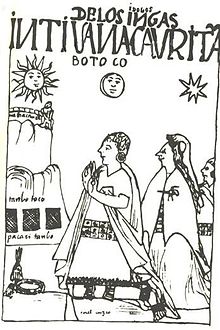|
Paqariq Tampu In Inca mythology, one of the main Incan creation myths was that of the Ayar Brothers, who emerged from a cave called Paqariq Tampu (also spelled Paqariqtampu) (Quechua paqariy 'to dawn, to be born', -q a suffix, tampu 'inn, lodge'; hispanicized and mixed spellings Pacaritambo, Paccarectambo, Paccarec Tambo, Paccarictambo, Paccaric Tambo, Paqariq Tambo, Paccaritambo). This "house of production" was located on the hill called Tampu T'uqu (Quechua t'uqu 'niche, hole or gap in the wall', today also the modern word for 'window'; hispanicized Tambotoco, Tamputoco). It had three windows. According to the myth, the tribe of Maras emerged from one of the niches, called Maras T'uqu (Maras tocco) by spontaneous generation.[1] The tribe of Tampus emerged from the sut'i t'uqu window. Manco Capac, his three Ayar brothers, and his four Mama sisters, emerged from the chief window in the middle, the qhapaq t'uqu.[2]: 28
References
G. Urton, The History of a Myth: Pacariqtambo and the Origin of the Inkas (Univ. of Texas Press, 1990)
|
Portal di Ensiklopedia Dunia